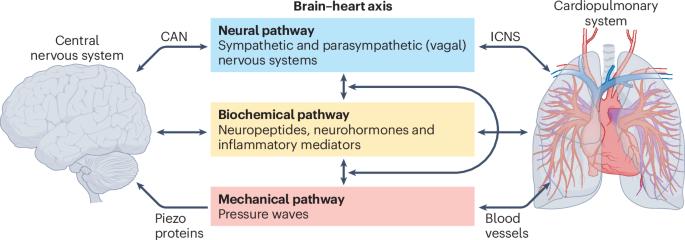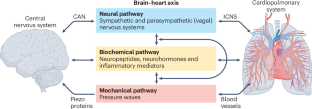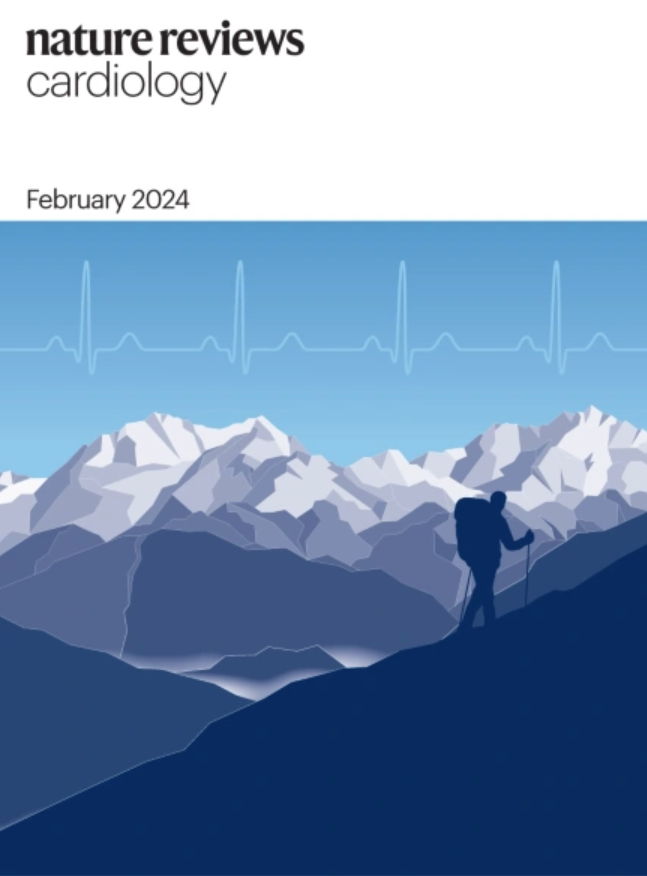The brain–heart axis: integrative cooperation of neural, mechanical and biochemical pathways
IF 44.2
1区 医学
Q1 CARDIAC & CARDIOVASCULAR SYSTEMS
引用次数: 0
Abstract
The neural and cardiovascular systems are pivotal in regulating human physiological, cognitive and emotional states, constantly interacting through anatomical and functional connections referred to as the brain–heart axis. When this axis is dysfunctional, neurological conditions can lead to cardiovascular disorders and, conversely, cardiovascular dysfunction can substantially affect brain health. However, the mechanisms and fundamental physiological components of the brain–heart axis remain largely unknown. In this Review, we elucidate these components and identify three primary pathways: neural, mechanical and biochemical. The neural pathway involves the interaction between the autonomic nervous system and the central autonomic network in the brain. The mechanical pathway involves mechanoreceptors, particularly those expressing mechanosensitive Piezo protein channels, which relay crucial information about blood pressure through peripheral and cerebrovascular connections. The biochemical pathway comprises many endogenous compounds that are important mediators of neural and cardiovascular function. This multisystem perspective calls for the development of integrative approaches, leading to new clinical specialties in neurocardiology. The brain–heart axis comprises the anatomical and functional interaction between the neural and cardiovascular systems that regulate physiological, cognitive and emotional states in both health and disease. In this Review, Valenza and colleagues explore the three primary pathways of the brain–heart axis — neural, mechanical and biochemical — discussing the regulatory mechanisms generated by each individual pathway and by interactions between the pathways.


脑-心轴:神经、机械和生化途径的综合合作
神经和心血管系统是调节人体生理、认知和情绪状态的关键,通过被称为脑心轴的解剖和功能连接不断相互作用。当这个轴功能失调时,神经系统疾病会导致心血管疾病,反过来,心血管功能障碍会严重影响大脑健康。然而,脑心轴的机制和基本生理成分在很大程度上仍然未知。在这篇综述中,我们阐明了这些组成部分,并确定了三个主要途径:神经,机械和生化。神经通路包括自主神经系统和大脑中枢自主神经网络之间的相互作用。机械途径涉及机械感受器,特别是那些表达机械敏感的压电蛋白通道,通过外周和脑血管连接传递有关血压的重要信息。生化途径包括许多内源性化合物,它们是神经和心血管功能的重要介质。这种多系统的观点要求综合方法的发展,导致神经心脏病学新的临床专业。
本文章由计算机程序翻译,如有差异,请以英文原文为准。
求助全文
约1分钟内获得全文
求助全文
来源期刊

Nature Reviews Cardiology
医学-心血管系统
CiteScore
53.10
自引率
0.60%
发文量
143
审稿时长
6-12 weeks
期刊介绍:
Nature Reviews Cardiology aims to be the go-to source for reviews and commentaries in the scientific and clinical communities it serves. Focused on providing authoritative and accessible articles enriched with clear figures and tables, the journal strives to offer unparalleled service to authors, referees, and readers, maximizing the usefulness and impact of each publication. It covers a broad range of content types, including Research Highlights, Comments, News & Views, Reviews, Consensus Statements, and Perspectives, catering to practising cardiologists and cardiovascular research scientists. Authored by renowned clinicians, academics, and researchers, the content targets readers in the biological and medical sciences, ensuring accessibility across various disciplines. In-depth Reviews offer up-to-date information, while Consensus Statements provide evidence-based recommendations. Perspectives and News & Views present topical discussions and opinions, and the Research Highlights section filters primary research from cardiovascular and general medical journals. As part of the Nature Reviews portfolio, Nature Reviews Cardiology maintains high standards and a wide reach.
 求助内容:
求助内容: 应助结果提醒方式:
应助结果提醒方式:


